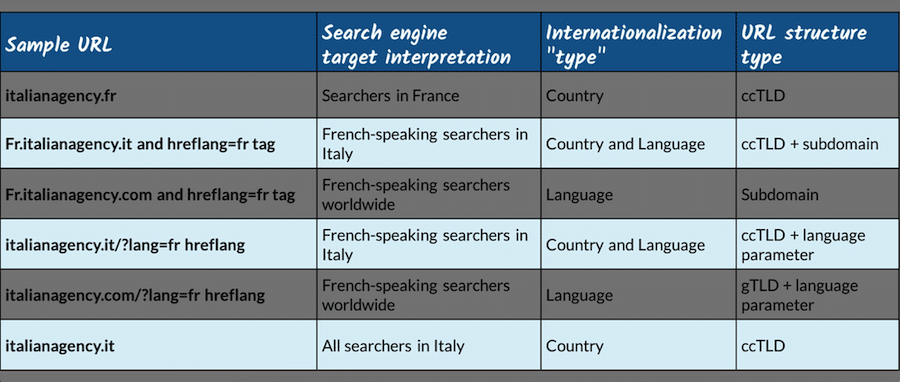Does your ecommerce site need to go international? If you know that a good share of your website visitors come from a different country than where you’re located, speak different languages, or both, then it may be time to make some changes to your website to create a better experience for all of your international visitors.
On the surface, international SEO may seem like a foreign concept, but in reality, you may be more familiar with it than you know. Think of international SEO as geotargeting, but instead of optimising your website to attract traffic from your city or state, you’re optimising it for different countries and languages.
If you’re looking to create a completely internationalised site (i.e., one that specifically targets a different country and a different language), your high-level to-dos for accomplishing this “international geotargeting” are threefold:
- Specify your target country and/or region with an international-friendly URL structure (country targeting).
- Establish which language your pages are targeting with the use of language tags (language targeting).
- Create and maintain content in your target users’ language(s). These are the raw materials with which you’ll rank.
Sometimes, you may be only looking to target a specific language or a specific country. In these cases, you may only want to work towards one or two of those three goals. Say, for example, you have an online clothing company that specializes in T-shirts with slogans in Spanish. Since Mexico is just as relevant to your business as Spain, you’d want to target the Spanish language, but not any specific country.

International SEO best practices for your ecommerce site
URL structures for international sites
There are a few URL structures webmasters can employ to target a particular country with their websites. They include using a country code top-level domain (ccTLD), a subdomain, a subdirectory or subfolder, a gTLD with language parameters, or even using a different domain name entirely.
ccTLD — As defined by Google, ccTLDs use two-letter codes to indicate to users and search engines in which country, sovereign state, or dependent territory a website is registered. Note that some country codes, like .ly for Libya, are used so commonly for other purposes that Google treats them generically.
Search engines may interpret each different URL structure slightly differently, so each technique has its pros and cons — including the resources required to implement and maintain them. Before choosing the right structure for you, it’s worth looking into more details about each option.
This table looks at a few combinations of potential URL structures that could be used to internationalize a site and who search engines interpret each structure as trying to target:

Whichever structure you choose, Google recommends that you similarly organies your hierarchy in each section of your site so that it’s intuitive and easily crawlable.
Language-target your ecommerce site for international marketing
Show search engines which languages you’re set up to handle using hreflang or language meta tags — bits of code that indicate in which language(s) your content is available. The following example would tell Google that an alternate version of the content is available in French at the link provided:
Example hreflang tag:
<link rel="alternate" href="http://example.com/fr" hreflang="fr-fr"/>
A few other best practices:
- Make sure that everything from your site navigation to your content, to your help desk, is in the primary language of the region you’re targeting.
- Don’t use machine translations (they’re still just not good enough).
- Don’t automatically redirect a user to a different language based on location. It’s fine to suggest an alternate language site, but you don’t know (without asking) if that English-language searcher in France is an expat, a student of a foreign language, or someone who’s lost on the internet.
- Stay away from using cookies or scripts to show different-language versions of the page. Search engines can’t crawl that type of dynamic content, and human users may not be able to see it, either.
Tailor your content to your target user’s language and culture
Make sure you are providing information that’s suited to your target audience(s). By using the local language, currency, and timezone together with contact information like addresses and phone numbers, you’re sending users and search engines strong signals that they’re in the right spot.
Also, think about cultural differences when you’re creating your design and content. Different regions look at things like colour, layout, and style of humour in very different ways.
By making it unambiguously clear that your page is for them, you’re increasing the chances that they’ll have a positive experience.
It’s also worth noting that, implemented properly, international SEO should be nearly invisible to users. They should simply get relevant content, in their language, and within their region (when applicable). So, the signals are far more about helping search engines show the right content to the right people than they are about cluing users in.
Other SEO signals
Other signals to show search engines that your site targets a specific country include:
- Hosting your site on a local IP
- Linking to local content
- Building links from local resources
- Finding ways to rank on local search engines like Yandex in Russia and Baidu in China
International targeting in a nutshell
If you’re targeting a specific country, think about using a ccTLD. But, if you are focusing on language targeting only, a ccTLD probably isn’t your best choice as they’re meant for targeting a specific geographic area and not specifically the language spoken there.
In these cases, you’ll likely want to use a different internationalization technique such as using hreflang, subfolders, or subdomains in combination with or instead of using a ccTLD. If you choose not to use a ccTLD for your internationally targeted site, check out this discussion of the pros and cons of subdirectories versus subdomains.





